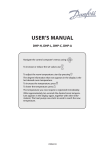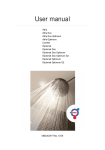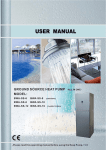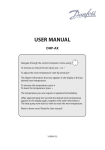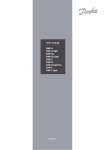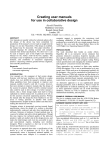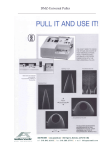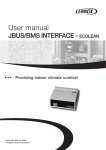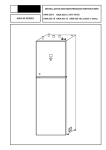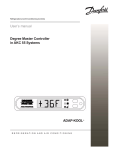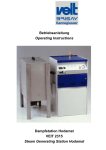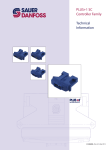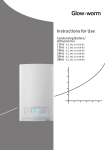Download USER`S MANUAL
Transcript
USER’S MANUAL DHP-AL Navigate through the control computer’s menu by: To increase or reduce the set values use: To adjust the room temperature: starting by pressing The degree information that now appears in the display is the last desired room temperature. To increase the temperature: press To lower the temperature: press The temperature you now require is registered immediately. (After approximately ten seconds the desired room temperature appears in the display again, together with other information.) The heat pump now starts to work to reach the new temperature. Want to know more? Read this User’s Manual! VUBMF102 Table of contents 1 Important information . . . . . . . . . . . . . . . . . . . . . . . . . . . . . . . . . . . . . . . . . . . . . . . . . . . . . . . 4 1.1 1.2 2 About your heat pump . . . . . . . . . . . . . . . . . . . . . . . . . . . . . . . . . . . . . . . . . . . . . . . . . . . . . . . 5 2.1 2.2 2.3 2.4 2.5 2.6 3 5 Instructions . . . . . . . . . . . . . . . . . . . . . . . . . . . . . . . . . . . . . . . . . . . . . . . . . . . . . . . . . . . . . . . . 25 Checking operation . . . . . . . . . . . . . . . . . . . . . . . . . . . . . . . . . . . . . . . . . . . . . . . . . . . . . . . . . . . . . . . . . . . . 29 Checking the brine level . . . . . . . . . . . . . . . . . . . . . . . . . . . . . . . . . . . . . . . . . . . . . . . . . . . . . . . . . . . . . . . . 29 Checking the water level in the heating system . . . . . . . . . . . . . . . . . . . . . . . . . . . . . . . . . . . . . . . . . 30 Checking the safety valve . . . . . . . . . . . . . . . . . . . . . . . . . . . . . . . . . . . . . . . . . . . . . . . . . . . . . . . . . . . . . . . 30 In the event of leakage . . . . . . . . . . . . . . . . . . . . . . . . . . . . . . . . . . . . . . . . . . . . . . . . . . . . . . . . . . . . . . . . . 31 Cleaning the strainer for the heating system . . . . . . . . . . . . . . . . . . . . . . . . . . . . . . . . . . . . . . . . . . . . 31 Cleaning the strainer for the brine circuit . . . . . . . . . . . . . . . . . . . . . . . . . . . . . . . . . . . . . . . . . . . . . . . . 32 Accessories . . . . . . . . . . . . . . . . . . . . . . . . . . . . . . . . . . . . . . . . . . . . . . . . . . . . . . . . . . . . . . . . . 33 7.1 8 Setting operating mode . . . . . . . . . . . . . . . . . . . . . . . . . . . . . . . . . . . . . . . . . . . . . . . . . . . . . . . . . . . . . . . . 25 Setting ROOM values . . . . . . . . . . . . . . . . . . . . . . . . . . . . . . . . . . . . . . . . . . . . . . . . . . . . . . . . . . . . . . . . . . . 25 Adjusting CURVE values . . . . . . . . . . . . . . . . . . . . . . . . . . . . . . . . . . . . . . . . . . . . . . . . . . . . . . . . . . . . . . . . 25 Adjusting a specific part of the heat curve . . . . . . . . . . . . . . . . . . . . . . . . . . . . . . . . . . . . . . . . . . . . . . 26 Setting MAX and MIN values . . . . . . . . . . . . . . . . . . . . . . . . . . . . . . . . . . . . . . . . . . . . . . . . . . . . . . . . . . . . 26 Setting HEATSTOP . . . . . . . . . . . . . . . . . . . . . . . . . . . . . . . . . . . . . . . . . . . . . . . . . . . . . . . . . . . . . . . . . . . . . . 26 Reading off temperatures . . . . . . . . . . . . . . . . . . . . . . . . . . . . . . . . . . . . . . . . . . . . . . . . . . . . . . . . . . . . . . . 27 Calculating energy consumption . . . . . . . . . . . . . . . . . . . . . . . . . . . . . . . . . . . . . . . . . . . . . . . . . . . . . . . 27 Manual defrost . . . . . . . . . . . . . . . . . . . . . . . . . . . . . . . . . . . . . . . . . . . . . . . . . . . . . . . . . . . . . . . . . . . . . . . . . 28 Regular checks . . . . . . . . . . . . . . . . . . . . . . . . . . . . . . . . . . . . . . . . . . . . . . . . . . . . . . . . . . . . . . 29 6.1 6.2 6.3 6.4 6.5 6.6 6.7 7 Display . . . . . . . . . . . . . . . . . . . . . . . . . . . . . . . . . . . . . . . . . . . . . . . . . . . . . . . . . . . . . . . . . . . . . . . . . . . . . . . . . 16 Menus . . . . . . . . . . . . . . . . . . . . . . . . . . . . . . . . . . . . . . . . . . . . . . . . . . . . . . . . . . . . . . . . . . . . . . . . . . . . . . . . . 18 Trimming the heating system . . . . . . . . . . . . . . . . . . . . . . . . . . . . . . . . . . . . . . . . . . . . . . . . 24 5.1 5.2 5.3 5.4 5.5 5.6 5.7 5.8 5.9 6 Principles of function . . . . . . . . . . . . . . . . . . . . . . . . . . . . . . . . . . . . . . . . . . . . . . . . . . . . . . . . . . . . . . . . . . . . . 5 Components . . . . . . . . . . . . . . . . . . . . . . . . . . . . . . . . . . . . . . . . . . . . . . . . . . . . . . . . . . . . . . . . . . . . . . . . . . . . . 6 Auxiliary heat . . . . . . . . . . . . . . . . . . . . . . . . . . . . . . . . . . . . . . . . . . . . . . . . . . . . . . . . . . . . . . . . . . . . . . . . . . . . 7 Water heater . . . . . . . . . . . . . . . . . . . . . . . . . . . . . . . . . . . . . . . . . . . . . . . . . . . . . . . . . . . . . . . . . . . . . . . . . . . . . 8 Regulation information . . . . . . . . . . . . . . . . . . . . . . . . . . . . . . . . . . . . . . . . . . . . . . . . . . . . . . . . . . . . . . . . . . . 9 Installation principle . . . . . . . . . . . . . . . . . . . . . . . . . . . . . . . . . . . . . . . . . . . . . . . . . . . . . . . . . . . . . . . . . . . . 14 Control computer . . . . . . . . . . . . . . . . . . . . . . . . . . . . . . . . . . . . . . . . . . . . . . . . . . . . . . . . . . . 15 3.1 3.2 4 Safety precautions . . . . . . . . . . . . . . . . . . . . . . . . . . . . . . . . . . . . . . . . . . . . . . . . . . . . . . . . . . . . . . . . . . . . . . . . 4 Protection . . . . . . . . . . . . . . . . . . . . . . . . . . . . . . . . . . . . . . . . . . . . . . . . . . . . . . . . . . . . . . . . . . . . . . . . . . . . . . . . 4 Room temperature sensor . . . . . . . . . . . . . . . . . . . . . . . . . . . . . . . . . . . . . . . . . . . . . . . . . . . . . . . . . . . . . . 33 Troubleshooting . . . . . . . . . . . . . . . . . . . . . . . . . . . . . . . . . . . . . . . . . . . . . . . . . . . . . . . . . . . . 34 8.1 Alarm . . . . . . . . . . . . . . . . . . . . . . . . . . . . . . . . . . . . . . . . . . . . . . . . . . . . . . . . . . . . . . . . . . . . . . . . . . . . . . . . . . 34 9 Terms and abbreviations . . . . . . . . . . . . . . . . . . . . . . . . . . . . . . . . . . . . . . . . . . . . . . . . . . . . 35 10 Default settings in the control computer . . . . . . . . . . . . . . . . . . . . . . . . . . . . . . . . . . . . . 37 11 References . . . . . . . . . . . . . . . . . . . . . . . . . . . . . . . . . . . . . . . . . . . . . . . . . . . . . . . . . . . . . . . . . . 38 11.1 Installation performed by: . . . . . . . . . . . . . . . . . . . . . . . . . . . . . . . . . . . . . . . . . . . . . . . . . . . . . . . . . . . . . . 39 VUBMF102 Danfoss – 3 1 Important information • If the installation is not used during the winter, the heating system must be drained of water, otherwise there is a risk of frost damage to the installation. (Contact an authorized installer, see the “References” section) • The installation can be considered maintenance free but certain checks are necessary (see “Regular checks”). • Before changing the control computer’s settings, first find out what these changes mean. • Contact your installer for any service work. 1.1 Safety precautions Installation and maintenance • Only authorized installers may install, operate and carry out maintenance and repair work on the heat pump. (See the“References” section) • Only authorized electricians may modify the electrical installation. (See the “References” section) DANGER TO LIFE! Only authorized refrigeration technicians may work on the refriger⚠⚠ant circuit. (See the “References” section). System modifications Only authorized installers may carry out modifications on the following components: • The heat pump unit • The pipes for the refrigerant, brine, water and power • The safety valve You must not carry out construction installations that may affect the operational safety of the heat pump. Safety valve The following safety precautions apply to the hot water circuit’s safety valve with corresponding overflow pipe: • Never block the connection to the safety valve’s overflow pipe. • Water expands when it is heated, this means that a small amount of water is released from the system via the overflow pipe. The water that exits the overflow pipe can be hot! Therefore, allow it to flow to a floor drain where there is no risk of burning yourself. 1.2 Protection Corrosion Protection Due to the risk of corrosion, avoid using different types of sprays in the vicinity of the heat pump. This particularly applies to: • Solvents • Chlorinated cleaning agents • Paints • Adhesives Danfoss – 4 VUBMF102 2 About your heat pump 2.1 Principles of function A heat pump utilises the free energy found in a natural heat source, such as rock, ground, or air. The heat pump can be compared to a reversed refrigerator. In a refrigerator, heat is transferred from the inside of the refrigerator to the outside. In a heat pump the heat that is stored in a heat source is transferred to the inside of the house. The heat pump uses the energy in the heat source and gives back two to three times more heat energy than what it uses in electrical energy. The heat pump is, therefore, a very environmentally friendly and economical way of heating a house. In order for the heat pump to be able to retrieve heating energy from the heat source and transfer it to the heating system of the house, three separate fluid circuits are required. The circuit that retrieves the heating energy from the heat source is called the brine circuit and it maintains a low outgoing temperature to be heated by the heat source. The next circuit is called the refrigerant circuit and is a closed circuit which takes the retrieves heating energy and transfers it to the last circuit, the heat transfer fluid circuit. The heat transfer fluid circuit holds the fluid that circulates in the heating system of the house and in the heat pump’s water heater. The figure below shows how the different circuits work together in the transfer of heating energy. Heating system and water heater Heat transfer fluid circuit – is the circuit that contains the water that transports the heat/energy to the heating system and the water heater. Condenser Expansion valve/ pressure drop Enclosed refrigerant Compressor/ pressure increasing Evaporator Refrigerant circuit – is the circuit that contains a chlorine and freon free refrigerant which, inside the heat pump, transfers the energy retrieved from the brine circuit through evaporation, compression and condensation, and supplies it to the heat transfer fluid circuit. Brine circuit – is the circuit that contains an antifreeze water based mix that obtains and transports energy from the heat source to the heat pump. This circuit is also known as the collector. Brine Heat source Figure 1: Function principles of a heat pump. 1 A fluid (brine) filled hose is lowered into a lake, buried in the ground or lowered into bedrock. The brine obtains energy from the heat source by the fluid temperature in the hose being heated a few degrees by the surrounding heat source. The fluid filled hose is also known as a collector. VUBMF102 Danfoss – 5 2 3 4 5 6 The brine is guided into the heat pump’s evaporator. The enclosed refrigerant in the refrigerant circuit is forced to boil as the pressure in the expansion valve drops and later evaporates to a gas in the evaporator. The energy produced during this process is released by the heated brine. The refrigerant that now contains a large quantity of energy in the form of heat is transferred to the compressor, which both increases its temperature and pressure. The refrigerant then continues to the condenser. When condensing, the refrigerant supplies its heat energy to the heat transfer fluid circuit. The refrigerant’s temperature decreases and returns to a liquid state. The heat transfer fluid circuit transports the heat energy out to the water heater, radiator or the under floor heating system, which heat up. The refrigerant is then transported through the expansion valve where the pressure drops and the refrigerant starts to boil and then the process starts again. 2.2 Components DHP-AL is a heat pump installation for both heating and producing domestic hot water for the home. The heat pump uses outdoor air as a heat source and retrieves energy from the air using an air heat exchanger in a separate outdoor unit. The compressor in the heat pump is first compressor on the market that is specially developed for heat pumps. It also has an integrated electrical heating element which provides auxiliary heat that can be used when the heating requirement exceeds the capacity of the heat pump. The heat pump supplies as much of the heat demand as possible before auxiliary heating is engaged and assists. The heat pump is equipped with control equipment, which is controlled via a control panel. The control equipment controls the heat pump unit’s included components (compressor, circulation pumps, auxiliary heater and outdoor unit) and determines when to start and stop the pump as well as producing heat and cooling for the house. Heat enters the house via a water borne heating system, a low temperature system. One is used to cool the house. The heat pump’s function for cooling connects automatically when the outdoor temperature exceeds the set parameter. The heat pump unit consists of five basic units: 1 Heat pump unit • Scroll compressor • Stainless steel heat exchanger (evaporator and condenser) • Circulation pumps for brine and heating systems • Valves and safety equipment and corresponding electrical components. 2 Auxiliary heat • 15 kW electric heating element (4.5 kW at 230 V heat pump installation) • Electric heating element control in a maximum of five steps (three steps for 230 V heat pump installation) • Installed on the heating system’s supply pipe • Covers the demand of extra energy if the heat pump’s capacity is exceeded • Automatically connected in the heat pump unit if operating mode AUTO is selected. 3 Control equipment (not shown in the figure) • Control computer with graphic display • Temperature sensors (outdoor, supply pipe, return pipe, brine and hot water) • Room sensor (option) Danfoss – 6 VUBMF102 4 Water heater • Water heater with defrosting tank 5 Outdoor unit • Air heat exchanger • Fan 2 3 4 1 5 Figure 2: Complete DHP-AL heat pump installation. 2.3 Auxiliary heat The auxiliary heater is made up of an electric heating element on the supply pipe that has three outputs, ADD.HEAT 1, ADD.HEAT 2 and ADD.HEAT 3, and can be controlled in five steps: • Step 1 = ADD.HEAT 1 = 3 kW • Step 2 = ADD.HEAT 2 = 6 kW • Step 3 = ADD.HEAT 1 + ADD.HEAT 2 = 9 kW • Step 4 = ADD.HEAT 2 + ADD.HEAT 3 = 12 kW • Step 5 = ADD.HEAT 1 + ADD.HEAT 2 + ADD.HEAT 3 = 15 kW To calculate the total energy consumption, see the “Settings- Calculating energy consumption” section. In the event of an alarm, the auxiliary heater engages automatically. VUBMF102 Danfoss – 7 2.4 Water heater Danfoss DHP-AL is supplied with an integrated 180 litre water heater with a tank outside the water heater that contains the anti-freeze. 1 Position 1 2 3 4 5 Name Hot water line Cold water Defrosting tank Water heater TWS coil 2 3 4 5 Figure 3: Water heater in DHP-AL. Using a regular time interval, the water in the water heater is heated to 60°C to prevent the build up of bacteria (legionella function). The factory set time interval is seven days. Hot water production is prioritised ahead of heat production, i.e. no heat is produced if there is a hot water demand at the same time. The temperature of the hot water cannot be adjusted. Hot water production does not cease at a determined temperature but when the compressor’s operating pressure switch reaches its maximum operating pressure, which corresponds to a hot water temperature of approximately 50-55°C. In the control computer’s TEMPERATURE menu, a number of measured and calculated temperatures for the hot water and supply are displayed. There you can see the current hot water temperature and the temperature of the supply pipe during heating and hot water production. The temperature of the supply pipe often exceeds the maximum permitted hot water temperature, but usually during hot water production. Danfoss – 8 VUBMF102 2.5 Regulation information Heat production - calculating The indoor temperature is adjusted by changing the heat pump’s heat curve, which is the control computer’s tool for calculating what the supply temperature should be for water that is sent out in the heating system. The supply temperature is calculated from the outdoor temperature and two adjustable values: CURVE and ROOM. The lower the outdoor temperature, the higher the supply temperature. In other words, the supply temperature of the water fed to the heating system will increase exponentially as the outside air temperature falls. The heat curve will be adjusted in connection with installation. It must be adapted later on, however, to obtain a pleasant indoor temperature in any weather conditions. A correctly set heat curve reduces maintenance and saves energy. CURVE The control computer shows the value for CURVE by means of a graph in the display. You can set the heat curve by adjusting the CURVE value. The CURVE value indicated which supply temperature the heating system is to have at an outdoor temperature of 0°C. Supply temperature Maximum supply temperature Value for CURVE is 40... Outdoor temperature ...at zero degrees Figure 4: Graph showing the set value 40 for CURVE. At outdoor temperatures colder than 0°C, supply water hotter than 40°C is sent out to the heating system and at outdoor temperatures greater than 0°C, supply water cooler than 40°C is sent out. VUBMF102 Danfoss – 9 Supply temperature Maximum supply temperature Outdoor temperature Figure 5: Increasing or reducing the CURVE changes the slope of the curve If you increase the CURVE value, the heat curve will become steeper and when you reduce it, it will become flatter. The most energy efficient and cost effective setting is achieved by changing the CURVE value to adjust the temperature in the house to an even and constant temperature. For a temporary increase or reduction, adjust the ROOM value instead. ROOM If you wish to increase or reduce the indoor temperature, change the ROOM value. The difference between changing the ROOM value and the CURVE value is that the system’s heat curve does not become steeper or flatter if the ROOM value is changed, which the curve becomes if the CURVE value changes, instead the entire heat curve is moved by 3°C for every degree change of the ROOM value. The reason that the curve is adjusted 3° is that an approximate 3° increase in supply temperature is needed to increase the indoor temperature 1°. Supply temperature Maximum supply temperature Outdoor temperature Figure 6: Changing the ROOM value changes the heat curve upwards or downwards. Danfoss – 10 VUBMF102 The relationship of the supply temperature to outdoor temperature will not be affected. The supply temperature will be increased or reduced by the same number of degrees all along the heat curve. I.E. the entire heat curve rises or drops instead of the curve gradient changing. This method of adjusting the indoor temperatures can only be for a rise or fall. Sometimes, at outdoor temperatures between -5°C and +5°C, part of the heat curve may need adjusting if the indoor temperature is not constant. For this reason, the control system includes a function adjusting the curve at three outdoor temperatures: -5°C, 0°C and +5°C. If, for example, the outdoor temperature is -5°C, the supply temperature will change gradually between 0°C and -10°C, maximum adjustment being reached at -5°C. The figure below shows the adjusted CURVE -5. The adjustment can be seen in the graph in the form of a bump. Supply temperature Local higher supply temperature at -5° Outdoor temperature Figure 7: The adjusted curve at -5°C You can choose to adjust the heat curve individually at three specified outdoor temperatures: -5°C, 0°C and +5°C. The supply temperature can be changed by plus/minus 5 degrees. HEATSTOP The HEATSTOP function automatically stops all production of heat when the outdoor temperature is equal to, or higher than, the value entered for heat stop. When the heat stop function is activated, the circulation pump will be turned off - except when hot water is being produced. The circulation pump will be "exercised" for 1 minute per day. The factory set value for activating heat stop is an outdoor temperature of 17°C. If the heat stop function is active, the outdoor temperature must drop 3°C when setting, before the heat stop stops. MIN and MAX The MIN and MAX values are the lowest, respectively highest set point values that are allowed for the supply temperature. Adjusting the minimum and maximum supply temperatures is particularly important if your home has under floor heating. If your house has under floor heating and parquet floors, the supply temperature must not exceed the recommendations of the floor manufacturer. Otherwise there is a risk that the parquet floors might be damaged If you have under floor heating and stone tiles, the MIN VUBMF102 Danfoss – 11 value should be 22-25°C, even in summer when no heating is required. Also remember that the value for HEATSTOP needs adjusting upwards for summer heating. This is to achieve a comfortable floor temperature. If your house has a basement, the MIN value should be adjusted to a suitable temperature for the basement in summer. A condition for maintaining the heat in the basement in the summer is that all radiators have thermostat valves that switch off the heat in the rest of the house. It is extremely important that the heating system in the house is trimmed correctly, see the “Trimming the heating system” section for further information. Also remember that the value for HEATSTOP needs adjusting upwards for summer heating. TEMPERATURES The heat pump can display a graph showing the history of the various sensors’ temperatures and you can see how they have changed over 100 measurement points in time. The time interval between the measurement points can be adjusted between one minute and one hour, factory setting is one minute. History is available for all sensors, but only the set value is shown in the display for the room sensor. The integral value that may appear is the heating system’s energy balance. INTEGRAL The information below tells you how your heat pump works, there are no values that you as a customer have to set. The heat demand in the house depends on the season and weather conditions and is not constant. The heat demand can be expressed as temperature difference over time and can be calculated giving an integral value as a result (heat demand). To calculate the integral value, the control computer uses several parameters. A heat deficit is needed to start the heat pump, and there are two integral values, A1 and A2, which start the compressor and auxiliary heater. During heat production, the deficit reduces and when the heat pump stops, the inertia in the system causes a surplus of heat. The integral value is a measurement of the surface under the time axle and is expressed in degree minutes. The figure below shows the factory settings for the integral values that the heat pump has. When the integral value has reached the set value for INTEGRAL A1, the compressor starts and if the integral value does not drop but continues to rise, the auxiliary heater starts when the integral value has reached the set value for INTEGRAL A2. INTEGRAL A1 INTEGRAL A1 INTEGRAL A2 Integral Heat surplus Heating deficit (Heat demand) INTEGRAL A2 Heat surplus Compressor stop (≥0) Time Compressor start (-60) Compressor start (-60) Auxiliary heater stop (latest at -60) Auxiliary heater start (-660) Auxiliary heater start (-660) Auxiliary heater No operation Compressor Auxiliary heater No operation Compressor Heat pump operation Figure 8: Starting and stopping heat pump operation based on integral values. Danfoss – 12 VUBMF102 The integral value calculation stops during hot water production and during heat stop. Integral value calculation resumes two minutes after completed hot water production to give the heating system time to stabilise the temperature. HYSTERESIS The information below tells you how your heat pump works, there are no values that you as a customer have to set. In order to start the heat pump in advance during sudden changes of the heat demand, there is a value, HYSTERESIS, which controls the difference between the actual supply temperature, t1 and the calculated supply temperature, t2. If the difference is the same or greater than the set HYSTERESIS value (x), i.e. there is a heat demand, or the heat demand disappears, quicker than the usual integral calculation, the integral value is forced to either the start value INTEGRAL A1 or to the stop value 0°min. t1 t2 SUPPLY TEMP. HYSTERESIS (∆t) ≥ x HYSTERESIS (∆t) ≥ x Compressor start (-60) TIME INTEGRAL Compressor stop (0) Figure 9: Conditions for HYSTERESIS to force the integral value to change. VUBMF102 Danfoss – 13 2.6 Installation principle The image shows the principles of a piping installation with all components. Safety valve Safety valve, 9 bar Supply sensor, brine Mixer valve Safety valve, 1.5 bar Filler cock Bleed valve Bleed valve 14 10 6 9 5 11 12 4 Bleed valve at stainless steel water heater Safety valve, 1.5 bar Location of the xpansion tank when e the outdoor unit is level with the heat pump. Shut-off valve 3 8 7 2 Filler cock 1 Brine flow during defrosting Figure 10: Principle solution for an installation. Danfoss – 14 13 Location of the expansion tank when the outdoor unit is higher than the heat pump. VUBMF102 3 Control computer A control computer is used to automatically calculate the heat demand in the house where the heat pump is installed and to ensure that the correct amount of heat is produced and emitted where necessary. There are many different values (parameters) that must be referred to during the calculation of the heat demand. Use the control computer to set and change certain values that have to be adapted according to the house demand. The display window, keypad and an indicator are on the front of the control computer. It consists of a simple menu system that is used to navigate the desired settings and values. ROOM 20°C (20°C) The symbols in the display are only examples. Certain symbols cannot be displayed at the same time. NO DEMAND HEAT OPERAT. AUTO Figure 11: Display, control buttons and indicator for the heat pump. Use the four control buttons on the keypad to navigate the menus and increase or reduce the set values: • An up button with a plus sign • A down button with a minus sign • A right button with a right arrow • A left button with a left arrow The display always shows the set ROOM value and the status of the heat pump. The main menu INFORMATION with its sub-menus. The main menu, INFORMATION, is opened by pressing the left or right buttons. From INFORMATION one of the four sub-menus can be opened: OPERAT.; HEATCURVE; TEMPERATURE and OPERAT. TIME. VUBMF102 Danfoss – 15 3.1 Display The display of the control computer shows information about the heat pump’s operation, status and any alarms, in text form. The status, indicated by symbols, is also shown in the lower section which shows the heat pump’s active process. Operating mode Appears with applicable heat pump operating status text. Operating mode (OFF) Meaning The installation is fully switched off. Remember that if the operating mode OFF is to be used for ⚠⚠long periods during the winter, the water in the heating system in the installation must be drained, otherwise there is a risk of frost damage. AUTO The heat pump and the auxiliary heater are automatically controlled by the control computer. HEATPUMP The control computer is controlled so that only the heat pump unit (compressor) is allowed to operate. ADD. HEAT The control computer only permits the auxiliary heater to be in operation. This operating mode can be used when a new installation is being used, when the brine system is not ready for operation. HOT WATER In this mode the heat pump only produces hot water, no heat goes to the heating system. Symbols Displays the operating status of the heat pump using symbols. Symbol VL Meaning HP Indicates that the compressor is in operation. An “F” next to the symbol indicates that a flow switch is installed. LIGHTNING Indicates that the auxiliary heater is in operation. Number of auxiliary power stages indicated by digit. HOUSE Indicates that the 3-way valve position is for heat production for the house. TAP Indicates that the 3-way valve’s position is for hot water production. SYSTEM Indicates the set system VL / D / VL+F / D+F (+F indicates that a flow switch is installed) CLOCK Indicates that tariff control is active. Danfoss – 16 VUBMF102 Symbol ⃞ Meaning TANK Indicates the temperature level in the water heater. During charging, the tank is filled and filling starts at the set start temperature. A lightning symbol by the symbol indicates peak heating charging (legionella function). SQUARE Either indicates that the operating pressure switch has deployed, or that the hot gas temperature has reached its maximum temperature. Symbols specific to DHP-AL Displays the operating status of the heat pump using symbols. Symbol Meaning DEFROST Displayed if defrosting is active. FAN Displayed if the fan is active L=Low speed and H= High speed. Text Appears with applicable heat pump operating status text. Message Meaning ROOM --°C Shows the set ROOM value. Factory setting: 20°C. If the room sensor accessory is installed, the actual temperature is first displayed and then the desired indoor temperature within brackets. ERR PHASE SEQ. Alarm that indicates that there is an incorrect phase sequence to the compressor. Only display and only the first 10 minutes. HIGH RETURN Indicates that the high return temperature prevents the compressor’s operation. START Indicates that there is a demand for heating production and that no start delay is active. EVU STOP Indicates that the additional function EVU is active. This means that the heat pump compressor and addition are off as long as EVU is active. NO DEMAND HEAT Indicates that there is no heating production demand. HIGHPRESS ERROR Alarm that indicates that the high pressure switch has deployed. LOWPRESS ERROR Alarm that indicates that the low pressure switch has deployed. MOTOR P ERROR Alarm that indicates that the motor protection has deployed. BRINEFLOW LOW Appears if the accessory flow switch is installed. Indicates that the flow in the brine system is low. VUBMF102 Danfoss – 17 Message Meaning SENSOR Alarm that indicates a faulty sensor. HEATPUMP START Indicates that the compressor will start within 30 seconds. The brine pump has started. HEATPUMP+ ADD.HEAT Indicates that heat production is active with both compressor and auxiliary heater. START --MIN Indicates that there is a heating production demand and will start in the specified number of minutes. ADD. HEAT Indicates that there is an auxiliary heater demand. DEFROST Indicates the temperature for defrost. 3.2 Menus 3.2.1 Main menu INFORMATION The control computer’s main menu, INFORMATION, is opened by pressing the right or left button once. Return INFORMATION Cursor OPERATION --HEATCURVE TEMPERATURE OPERAT.TIME DEFROST Sub-menus Figure 12: The main menu INFORMATION for DHP-AL with sub menus. Use the up and down buttons to select the desired sub-menu and open the menu by pressing the right button once. To go back to the display’s starting point, press the left button once. Danfoss – 18 VUBMF102 3.2.2 Sub-menu OPERATION In the OPERATION menu you can set the operating mode of the heat pump. When changing operating mode, confirm your choice by pressing the right button once. The asterisk moves to the selected operating mode. For further information, see the “Setting operating mode” section. Menu text (OFF) OPERATION AUTO HEATPUMP ADD. HEAT HOT WATER * Description Adjusted by: The installation is fully switched off. By the customer, if necessary. Remember that if the operating ⚠⚠mode OFF is to be used for long periods during the winter, the water in the heating system in the installation must be drained, otherwise there is a risk of frost damage. AUTO The heat pump and the auxiliary heater are automatically controlled by the control computer. By the customer, if necessary. HEATPUMP The control computer is controlled so that only the heat pump unit (compressor) is allowed to operate. By the customer, if necessary. ADD. HEAT The control computer only permits the By the customer, if auxiliary heater to be in operation. This necessary. operating mode can be used when a new installation is being used, when the brine system is not ready for operation. HOT WATER In this mode the heat pump only produces hot water, no heat goes to the heating system. VUBMF102 By the customer, if necessary. Danfoss – 19 3.2.3 Sub-menu HEATCURVE In the HEATCURVE menu the settings that affect the indoor temperature are made. For further information, see the “About your heat pump” section. HEATCURVE CURVE MIN MAX CURVE 5 CURVE 0 CURVE -5 HEATSTOP Menu text Description Adjusted by: CURVE The set value indicates the supply line temperature of the water that is transported to the heating system at an outdoor temperature of 0°C. By the customer, if necessary. MIN Sets the lowest permitted supply temperature. By the customer, if necessary. MAX Sets the highest permitted supply temperature. By the customer, if necessary. CURVE 5 Used to adjust the heat curve at an outdoor temperature of +5°C. By the customer, if necessary. CURVE 0 Used to adjust the heat curve at an outdoor temperature of 0°C. By the customer, if necessary. CURVE - 5 Used to adjust the heat curve at an outdoor temperature of -5°C. By the customer, if necessary. HEATSTOP This function stops all production of By the customer, if heat when the outdoor temperature is necessary. equal to, or higher than, the set heat stop value. REDUCTION The temperature can be lowered using an outside timer. The control computer determines the drop. By the customer, if necessary. ROOM FACTOR Determines how large an impact the room temperature is to have when calculating the supply temperature. Factory setting: 2 (interval: 1 - 5) (1 = small, 5 = large) (Only displayed if a Room sensor is installed.) Danfoss – 20 VUBMF102 40°c 22°c 70°c 0°c 0°c 0°c 17°c 3.2.4 Sub-menu TEMPERATURE In the TEMPERATURE menu you are able to view the various temperatures that the installation has had. All temperatures are stored 100 minutes (factory setting) back in time so that they can also be displayed in the form of graphs. TEMPERATURE OUTDOOR ROOM SUPPLY PIPE RETURN PIPE HOT WATER INTEGRAL BRINE OUT 0°c 20°c 38(40)°c 34(48)°c 52°c -660 -7°c Menu text Description Adjusted by: OUTDOOR Outdoor temperature ROOM If ROOM shows 20°C the heat curve is unaffected. If ROOM shows higher or lower, this indicates that the heat curve has been adjusted up or down to change the indoor temperature. SUPPLY PIPE Shows the actual supply temperature. (The desired value is shown between brackets.) Not adjustable (The computer calculates the temperature Read the “Regulation information” section required to maintain the indoor temperafor more information. ture.) (In operating mode ADD.HEAT the stop temperature for hot water production is shown in brackets.) RETURN PIPE Shows the read return temperature. (The highest permitted temperature is shown between brackets.) Authorized installer. HOT WATER Shows the actual hot water temperature. Not adjustable INTEGRAL Heat production is controlled by a calculated demand that is automatically calculated when the installation is in operation. The integral is the heat system’s energy balance. Not adjustable By the customer, if necessary. Adjusted for each installation. Read the “Regulation information” section for more information. BRINE OUT The temperature of the brine circuit going out from the heat pump. Not adjustable BRINE IN The temperature of the brine circuit going into the heat pump. Not adjustable VUBMF102 Danfoss – 21 3.2.6 Sub-menu OPERAT.TIME In the OPERAT.TIME menu you are able to view the operating time of the installation. Operating times cannot be reset but are accumulated during the service life of the heat pump. The control computer calculates the operating time in minutes but only complete hours are shown in the display. OPERAT.TIME HEATPUMP ADD. HEAT 1 ADD. HEAT 2 ADD. HEAT 3 HOT WATER Menu text Description Adjusted by: HEATPUMP Shows the total time in hours that the heat pump has been in operation since installation. The number of operating hours includes the time for both heat production and hot water production. Not adjustable ADD. HEAT 1 Shows the total time in hours that the Not adjustable auxiliary heater (3 kW) has been in operation since installation. ADD. HEAT 2 Shows the total time in hours that the Not adjustable auxiliary heater (6 kW) has been in operation since installation. ADD. HEAT 3 Shows the total time in hours that the Not adjustable auxiliary heater (6 kW) has been in operation since installation. HOT WATER Shows a part of the time that is included in the HEAT PUMP value. The number of hours that hot water production has been in operation since installation are shown here. 0H 0H 0H 0H 0H Not adjustable The additional heater is made up of an electric heating element on the supply pipe that has three different outputs, ADD.HEAT 1 (3kW), ADD.HEAT 2 (6kW), and ADD. HEAT 3 (6kW), and can be controlled in fives steps: • Step 1 = ADD.HEAT 1 = 3 kW • Step 2 = ADD.HEAT 2 = 6 kW • Step 3 = ADD.HEAT 1 + ADD.HEAT 2 = 9 kW • Step 4 = ADD.HEAT 2 + ADD.HEAT 3 = 12 kW • Step 5 = ADD.HEAT 1 + ADD.HEAT 2 + ADD.HEAT 3 = 15 kW Danfoss – 22 VUBMF102 3.2.7 Sub-menu DEFROST In the “DEFROST” menu it is possible to view miscellaneous information about the defrost and also possible to make adjustments. DEFROST DEFROSTS BETW. 2 DEFR TIME SINCE DEFROST FAN H OFF AT DEFROST CURVE MANUEL DEFR 0S 0M 0M 12°c 0 Menu text Description DEFROSTS Total number of defrosts carried out since Not adjustable installation, i.e. the number not reset. Adjusted by: BETW. 2 DEFR The operating time of the compressor in minutes between the 2 last defrosts. Not adjustable TIME SINCE DEFROST The operating time of the compressor in minutes since last defrost. Reset after a defrost is completed. Not adjustable FAN H OFF AT Fan high speed is deactivated at this outdoor temperature and low speed is activated. By the customer, if necessary. DEFROST CURVE Here, the angle of the defrost curve can be changed using the right-hand arrow and by either pressing + or -. (Change the start temperature for when defrosting is to begin). By the customer, if necessary. MANUEL DEFR By using the right-hand arrow and then pressing +, defrost can be started manually (shunts +20°C for 10 minutes). By the customer, if necessary. VUBMF102 Danfoss – 23 4 Trimming the heating system To obtain a heating system balance and obtain an even and comfortable indoor temperature, you must adjust your heating system according to the example below. ⚠⚠ Adjust the heating system during the winter to obtain the greatest possible output. Trimming must be carried out over a few days as the inertia in the heating system ⚠⚠causes the indoor temperature to change slowly. 1 2 3 4 5 6 7 8 9 Choose one of the house’s rooms as a reference room for the indoor temperature, where the highest temperature is required, 20-21°C. Place a thermometer in the room. Open all the heating system’s radiator valves fully. Leave the heat pump’s ROOM value set at 20°C. See the “Instructions – Setting the ROOM value” section for further information. Note the temperature in the reference room at different points in time over a 24 hour period. Adjust the ROOM value so that the reference room reaches your desired indoor temperature of 20-21°C. Remember that other rooms will have different temperatures during trimming, but these can be adjusted later. If the ROOM value must be adjusted more than 3°C upwards or downwards the CURVE value must be adjusted instead. See the “Instructions – Adjusting the CURVE value” section for further information. If the indoor temperature varies several degrees despite trimming, a specific part of the heat curve may need adjusting. .Check at what outdoor temperature the variation is greatest and adjust the curve at the corresponding value (CURVE 5, CURVE 0, CURVE -5). See the “Instructions – Adjusting a specific part of the heat curve” section for further information. When the reference room has an even temperature of 20-21°C over a 24 hour period, you can adjust the radiator valves in the other rooms so that their indoor temperatures are the same temperature or lower than the reference room. Danfoss – 24 VUBMF102 5 Instructions An authorized installer carries out the basic settings of the heat pump at installation. You can carry out the following yourself: • Setting operating mode • Setting ROOM values • Adjusting CURVE values • Adjusting a specific part of the heat curve • Setting the desired maximum and minimum supply temperature • Setting HEATSTOP • Reading off the hot water temperature or different temperatures in the heat pump • Calculate the heat pump’s total energy consumption • Defrost the outdoor unit 5.1 Setting operating mode In the control computer you can choose between five operating modes. To change the operating mode: 1 Press either the right or left button once to open the INFORMATION main menu. The cursor is in the OPERATION menu option. 2 Open your selection by pressing the right button once. An asterisk indicates the current operating mode. 3 Mark the new desired operating mode using the up or down button. 4 Press the right button once to confirm your choice. The asterisk moves to your selected operating mode. 5 Press the left button twice to exit the menu. 5.2 Setting ROOM values If the indoor temperature is too high or too low, you can adjust the ROOM value to change the indoor temperature. To change the ROOM value: 1 Press either the up or the down button once to open and change the ROOM value. 2 Raise or reduce the ROOM value using the up or down buttons to change the indoor temperature. 3 Wait ten seconds or press the left button once to exit the menu. 5.3 Adjusting CURVE values To change the CURVE value: 1 Press either the right or left button once to open the INFORMATION main menu. The cursor is in the OPERATION menu option.. 2 Press the down button to move the cursor to the HEATCURVE menu option. 3 Open the menu by pressing the right button once.. The cursor is at CURVE. 4 Open your selection by pressing the right button once. VUBMF102 Danfoss – 25 5 6 Raise or reduce the value with the up or down buttons. The graph shows how the curve slope changes. Press the left button three times to exit the menu. 5.4 Adjusting a specific part of the heat curve To change a specified part of the heat curve: 1 Press either the right or left button once to open the INFORMATION main menu. The cursor is in the OPERATION menu option. 2 Press the down button to move the cursor to the HEATCURVE menu option. 3 Open the menu by pressing the right button once. The cursor is at the CURVE value. 4 Select CURVE 5, CURVE 0 or CURVE -5 using the up or down buttons. 5 Open your selection by pressing the right button once. 6 Raise or reduce the value with the up or down buttons. 7 Press the left button three times to exit the menu. 5.5 Setting MAX and MIN values To change MIN or MAX: 1 Press either the right or left button once to open the INFORMATION main menu. The cursor is in the OPERATION menu option. 2 Press the down button to move the cursor to the HEATCURVE menu option. 3 Open the menu by pressing the right button once. The cursor is at the CURVE value. 4 Press the down button to move the cursor to MIN. 5 Open your selection by pressing the right button once. The text row MIN is marked. 6 Raise or reduce the value with the up or down buttons. 7 Press the left button three times to exit the menu. Repeat the procedure to change the MAX value, but select MAX instead of MIN at step 4. 5.6 Setting HEATSTOP To change HEATSTOP: 1 Press either the right or left button once to open the INFORMATION main menu. The cursor is in the OPERATION menu option. 2 Press the down button to move the cursor to the HEATCURVE menu option. 3 Open the menu by pressing the right button once. The cursor is at the CURVE value. 4 Press the down button to move the cursor to HEATSTOP. 5 Open your selection by pressing the right button once. The text row HEATSTOP is marked. 6 Raise or reduce the value with the up or down buttons. 7 Press the left button three times to exit the menu. Danfoss – 26 VUBMF102 5.7 Reading off temperatures Reading the hot water temperature. 1 Press either the right or left button once to open the INFORMATION main menu. The cursor is in the OPERATION menu option. 2 Press the down button to move the cursor to the TEMPERATURE menu option. 3 Open your selection by pressing the right button once. 4 Press the down button to move the cursor to HOTWATER. The value shown at the HOTWATER menu option is the hot water’s current value. 5 Open your selection by pressing the right button once. A graph of the hot water temperature over the last hour is shown. 6 Press the left button three times to exit the menu. To view the TEMPERATURE history: 1 Press either the right or left button once to open the INFORMATION main menu. The cursor is in the OPERATION menu option. 2 Press the down button to move the cursor to the TEMPERATURE menu option. 3 Open the menu by pressing the right button once. 4 The cursor is at the OUTDOOR value. 5 Press the up or down button to move the cursor to the desired value. 6 Open your selection by pressing the right button once. A graph appears in the display. 7 Move the cursor along the time axis using the up (plus) or down (minus) buttons. An exact value at the relevant time is shown at the top of the display. 8 Press the left button three times to exit the menu. 5.8 Calculating energy consumption The energy consumption calculation is difficult to specify exactly, but the average output for a normal house with normal hot water consumption in the following tables gives a relatively accurate result for each heat pump and heating system. Remember that the operating time for the heat pump installation must exceed one year before the specified values in the table are valid. The energy consumption for legion operation is included in the hours for ADD.HEAT 1. The specified outputs include the circulation pumps and also the outdoor unit’s fan. DHP-AL 6 8 10 12 Under floor heating 1.90 kW 2.60 kW 3.00 kW 3.50 kW Radiators 2.30 kW 3.05 kW 3.50 kW 4.10 kW To calculate the energy consumption: 1 Press either the right or left button once to open the INFORMATION main menu. The cursor is in the OPERATION menu option. 2 Press the down button to move the cursor to the OPERAT.TIME menu option. VUBMF102 Danfoss – 27 3 4 5 6 7 8 9 Open the menu by pressing the right button once. Note how many hours the following values have: HEAT PUMP, ADD.HEAT 1, ADD.HEAT 2 and ADD.HEAT 3. Find the value for the average output that corresponds to your heat pump and heating system in the table above, and multiply it by the number of HEAT PUMP hours. Note the result. Multiply the number of ADD.HEAT 1 hours by 3. Note the result. Multiply the number of ADD.HEAT 2 hours by 6. Note the result. Multiply the number of ADD.HEAT 3 hours by 6. Note the result. Add up the multiplied values to obtain the total energy consumption. 5.9 Manual defrost If the outdoor unit requires defrosting you can run a defrosting procedure manually from the control computer. To defrost manually: 1 Press either the right or left button once to open the INFORMATION main menu. The cursor is in the OPERATION menu option. 2 Press the down button to move the cursor to the DEFROST menu option. 3 Open the menu by pressing the right button once. 4 Press the down button to move the cursor to the MANUAL DEFROST menu option. 5 Press the right button once. 6 Press the up button once to start defrost. 7 Press the left button three times to exit the menu. Danfoss – 28 VUBMF102 6 Regular checks 6.1 Checking operation During normal operation, the alarm indicator lights green continuously to show that everything is OK. When the alarm is triggered, it flashes green at the same time as a text message is shown in the display. ALARM LOWPRESS ERROR Figure 13: Flashing alarm indicator in the event of an alarm. Regularly check the alarm indicator to ensure that the installation is working correctly. It is not always the case that you will notice a problem with the installation, for example, in the event of a fault with the compressor the auxiliary heater starts automatically (operating mode AUTO). For further information about alarms, see the “Troubleshooting” section. 6.2 Checking the brine level The brine circuit must be filled with the correct amount of fluid otherwise the installation may become damaged. The brine must be topped up when the level drops so that it is no longer visible in the expansion tank. VUBMF102 Danfoss – 29 Level too low Level correct Figure 14: Level in expansion tank. During the first month of operation the brine level might drop a little, which is quite normal. The fluid level may also vary depending on the temperature of the heat source. Under no circumstances, however, must the fluid level be allowed to drop so much that it is no longer visible in the expansion tank. For DHP-AL with pressurized brine circuit the manometer on the expansion tank must show approx. 1.0 bar, see figure in section “Installation principle” for more information about the location of the expansion tank. Always call your installer to refill brine, see the “References” section. 6.3 Checking the water level in the heating system The line pressure of the installation must be checked once a month. The external manometer must show a value between 1-1.5 bar. If the value is below 0.8 bar, when the water in the heating system is cold, the water must be topped up (applies in the event of an empty expansion tank). See the “Piping installation (principle solution)” section for information on where the manometer is located. You can use normal tap water when topping up the heating system. In certain exceptional cases the water quality may be so poor (for example very hard water) that it is not suitable for filling the heating system. If unsure, contact your installer, see the “References” section. ⚠⚠ Do not use any additives for water treatment in the heating system’s water! 6.4 Checking the safety valve Both the safety valves for the heating system must be checked at least four times a year to prevent lime deposits clogging the mechanism. See the “Installation principle” section for information on where the safety valves are located. The safety valve of the water tank protects the enclosed heater against over pressure in the water tank. It is mounted on the cold water inlet line, its outlet opening facing downwards. If the safety valve is not checked regularly, the water tank might be damaged. It is quite normal that the safety valve lets out small amounts of water when the water tank is being charged, especially if a lot of hot water was used previously. Danfoss – 30 VUBMF102 Both safety valves can be checked by turning the cap a quarter of a turn clockwise until the valve lets out some water through the overflow pipe. If a safety valve does not work properly, it must be replaced. Contact an authorized installer, see the “References” section. The opening pressure of the safety valves is not adjustable. 6.5 In the event of leakage In the event of leakage in the hot water pipes between the heat pump and water taps, close the shut-off valve on the cold water inlet immediately. Contact an authorized installer, see the “References” section. 6.6 Cleaning the strainer for the heating system ⚠⚠ The heat pump must be switched off at the main switch before cleaning can be started. The brine circuit’s strainer must be cleaned twice a year after installation. The interval ⚠⚠can be extended if there is evidence that cleaning twice a year is not necessary. Strainer Shut-off valve O-ring Cover Figure 15: Shut-off cock and strainer on the return pipe. NOTE! Have a cloth to hand when opening the strainer cover as a small amount of water usually escapes. To clean the strainer: 1 Switch off the heat pump. 2 Turn the shut-off cock to the closed position (see figure above). 3 Unscrew the cover and remove it. 4 Remove the strainer. 5 Rinse the strainer. 6 Reinstall the strainer. 7 Check that the o-ring on the cover is not damaged. 8 Screw the cover back into place. 9 Turn the shut-off cock to the open position. 10 Start the heat pump. VUBMF102 Danfoss – 31 6.7 Cleaning the strainer for the brine circuit ⚠⚠ The heat pump must be switched off at the main switch before cleaning can be started. The brine circuit’s strainer must be cleaned twice a year after installation. The interval ⚠⚠can be extended if there is evidence that cleaning twice a year is not necessary. Cover O-ring Strainer Shut-off valve Shut-off valve Figure 16: Strainer in the filler cock. To clean the strainer: 1 Switch off the heat pump. 2 Remove the insulation around the filler cock. 3 Turn both shut-off cocks to the closed position (see figure above). 4 Unscrew the cover and remove it. 5 Remove the strainer. 6 Rinse the strainer. 7 Reinstall the strainer. 8 Check that the o-ring on the cover is not damaged. 9 Screw the cover back into place. 10 Turn both shut-off cocks to the open position. 11 Reinstall the insulation around the filler cock. 12 Start the heat pump. Danfoss – 32 VUBMF102 7 Accessories 7.1 Room temperature sensor Contact your installer if you wish to supplement your heat pump installation with a room temperature sensor, see the “References” section. The room sensor is an accessory that is used to set a desired indoor temperature. It can be installed in the house where the room temperature is relatively constant, not in a hallway, kitchen or a room with alternative heating. On the room sensor you can set the desired room temperature and view the outdoor temperature. In the room temperature sensor there is a temperature sensor that provides a further value that the control computer can use when calculating the supply temperature. The influence of the room sensor in the calculation can be set in the menu HEAT CURVE-> ROOM FACTOR. Default setting for ROOM FACTOR is 2 but can be adjusted from 1 (no impact) to 5 (large impact). • The room sensor’s display shows the actual indoor temperature in normal mode. • To display the outdoor temperature press the up and down buttons at the same time. • To set the desired indoor temperature press either the up or down button. • If the heat pump has an active alarm the text AL appears in the display. VUBMF102 Danfoss – 33 8 Troubleshooting 8.1 Alarm In the event of an error message try restarting the installation using the installation’s safety switch. If restarting the heat pump does not help try rectifying the problem using the table below. Contact your installer, see the “References” section, if you are unable to rectify the problem yourself. Message Meaning Cause Remedy LOWPRESS ERROR LOWPRESS ERROR - The compressor stops and there is no hot water production. Not enough fluid in the brine system. Air in the brine system. Blocked filter in the brine system. Contact your installer. HIGHPRESS ERROR HIGHPRESS ERROR - The compressor stops and there is no hot water production. Insufficiently opened radiator/ floor loop thermostats. Air in the heating system. Blocked strainer in the heating system. Open radiator / floor loop thermostats. Top up and bleed the heating system or contact your installer. MOTOR P ERROR Motor protection cut out. The compressor stops and there is no hot water production. Power failure caused by a blown fuse or the safety switch has deployed. Check the fuses and reset the safety switch. ALARM AUXILIARY HEATER Overheating protection deployed. Electrical fault. The Contact your safety switch has installer. tripped. SENSOR OUTDOOR Fault in outside sensor. To calculate the supply temperature’s desired value, use 0°C instead. Electrical fault. Contact your installer. SENSOR FRONT Incorrect supply pipe sensor. Everything stops except the circulation pump for the heating system. Electrical fault. Contact your installer. SENSOR RETURN Return sensor fault. Electrical fault. Contact your installer. SENSOR HOT WATER Fault in the hot water sensor. No hot water production. Electrical fault. Contact your installer. Danfoss – 34 VUBMF102 Message Meaning Cause Remedy ALARM ROOM SENSOR The actual room temperature is not displayed. To calculate the supply temperature’s desired value, use 20°C instead. Electrical fault. Contact your installer. ERR PHASE SEQ. The compressor in the heat pump is operating in the wrong direction and this means that only the auxiliary heater is maintaining heating. Contact your The phase sequence changed installer. when changes were made in the electrical installation of the house. HIGH RETURN The temperature of the water that returns from the radiators is too high and prevents the heat pump from working. Insufficiently opened radiator/ floor loop thermostats. 9 Ensure that all thermostat valves are fully open. Terms and abbreviations Term Explanation Evaporator In the evaporator, energy from the heat source is absorbed by the refrigerant passing through the evaporator. The refrigerant turns into gas. (See the “About your heat pump” section for further information). INTEGRAL INTEGRAL is the heating system’s energy balance. Heat generation is controlled by a calculated requirement. This value is determined by comparing the actual supply temperature with its calculated supply temperature. The difference between the temperatures is multiplied by the time during which the difference is active. The resulting value is referred to as the integral. The integral value is automatically established when the heating system is in use. The value of the integral can be viewed in the display under the submenu TEMPERATURE. Compressor The compressor raises the temperature and pressure of the refrigerant. (See the “About your heat pump” section for further information). Condenser In the condenser, the refrigerant supplies its heat energy to the heat transfer fluid circuit. (See the “About your heat pump” section for further information). CURVE The CURVE value is set via the display. The set value indicates the supply temperature of the water that is transported to the radiators at an outdoor temperature of 0°C. Brine Is a water based mixture that transports energy from the heat source to the heat pump. (See the “About your heat pump” section for further information). VUBMF102 Danfoss – 35 Term Explanation Brine circuit The fluid circuit transports energy from the heat source to the heat pump. (See the “About your heat pump” section for further information). Refrigerant circuit Is the circuit in the heat pump that through evaporation, compression and condensation takes energy from the brine circuit and supplies it to the heat transfer fluid circuit. (See the “About your heat pump” section for further information). Refrigerant Is the fluid that transports heat from the brine circuit and supplies it to the heat transfer fluid circuit. (See the “About your heat pump” section for further information). Radiator Heater element, element. Control computer The control computer controls the entire heating installation. All settings are stored and the history of the installation is registered here. The control computer’s settings can be changed via the display. ROOM If ROOM shows 20°C the heat curve is unaffected. If ROOM shows higher or lower, this indicates that the heat curve has been adjusted up or down to change the indoor temperature. Heat transfer fluid circuit The fluid circuit obtains heat/energy from the refrigerant circuit, which it then transports to the water tank or heating system. See the “About your heat pump” section for further information. Heat curve The control computer determines the correct temperature of the water to be distributed to the heating system based on the heat curve. The indoor temperature is adjusted by changing the gradient of the heating system’s CURVE. Danfoss – 36 VUBMF102 10 Default settings in the control computer The first column in the table below shows the parameters that can be adjusted by the User. The second column shows settings made at the factory, and the third column the settings made by the installation contractor in connection with installation of the heat pump. Make sure that the installation contractor enters any settings made during installation that are particular to your heat pump. This will make it easier for you when you make your own adjustments. Setting Factory setting ROOM 20°C OPERATION AUTO CURVE 40°C MIN 10°C MAX 55°C CURVE 5 0°C CURVE 0 0°C CURVE -5 0°C HEATSTOP 17°C REDUCTION 2°C Any customer specific settings VUBMF102 Danfoss – 37 11 References Installed model: . . . . . . . . . . . . . . . . . . . . . . . . . . . . . . . . . . . . . . . . . . . . . . . • Setting up □ Surface adjustment • Piping installation □ Leak test □ Bleeding □ Open radiator valves □ Function test safety valve • Electrical Installation □ Direction of rotation of the compressor □ Outdoor sensor □ Accessories: . . . . . . . . . . . . . . . . . . . . . . . . . . . . . . . . . . . . . . . . . . . . . . . . . . . • Brine installation □ Type of brine: . . . . . . . . . . . . . . . . . . . . . . . . . . . . . . . . . . . . . . . . . . □ Filling, number of litres: . . . . . . . □ Leak test □ Function test safety valve • Control computer □ Basic settings • Test operation □ Manual test carried out □ Noise check • Customer information □ Control computer, menus, maintenance instructions □ Checking and filling, heating system □ Alarm information □ Function test safety valve □ Strainers, cleaning □ Trimming information □ Warranties Danfoss – 38 VUBMF102 11.1 Installation performed by: PIPE INSTALLATION Date . . . . . . . . . . . . . . . . . . . . . . . . . . . . . . . . . . . . . . . . . . . . . . . . . . . . . . Company . . . . . . . . . . . . . . . . . . . . . . . . . . . . . . . . . . . . . . . . . . . . . . . . . . Name . . . . . . . . . . . . . . . . . . . . . . . . . . . . . . . . . . . . . . . . . . . . . . . . . . . . . Tel. No. . . . . . . . . . . . . . . . . . . . . . . . . . . . . . . . . . . . . . . . . . . . . . . . . . . . . ELECTRICAL INSTALLATION Date . . . . . . . . . . . . . . . . . . . . . . . . . . . . . . . . . . . . . . . . . . . . . . . . . . . . . . . Company . . . . . . . . . . . . . . . . . . . . . . . . . . . . . . . . . . . . . . . . . . . . . . . . . . Name . . . . . . . . . . . . . . . . . . . . . . . . . . . . . . . . . . . . . . . . . . . . . . . . . . . . . . Tel. No. . . . . . . . . . . . . . . . . . . . . . . . . . . . . . . . . . . . . . . . . . . . . . . . . . . . . If these instructions are not followed during installation, operation and maintenance, Danfoss AS’s liability according to the applicable warranty is not binding. Danfoss AS retains the right to make changes to components and specifications without prior notice. VUBMF102 Danfoss – 39 Danfoss – 40 VUBMF102 VUBMF102 Danfoss – 41 VUBMF102











































